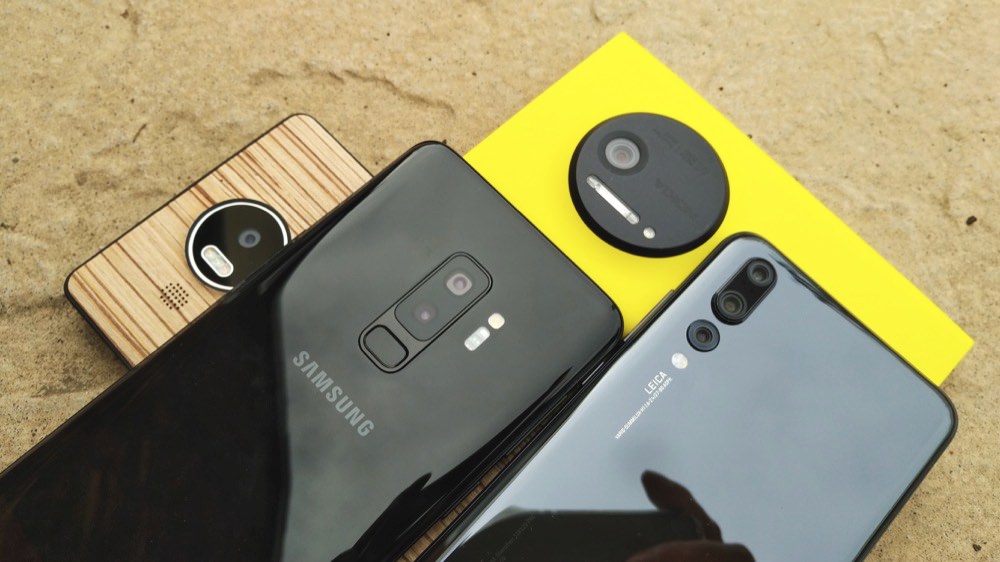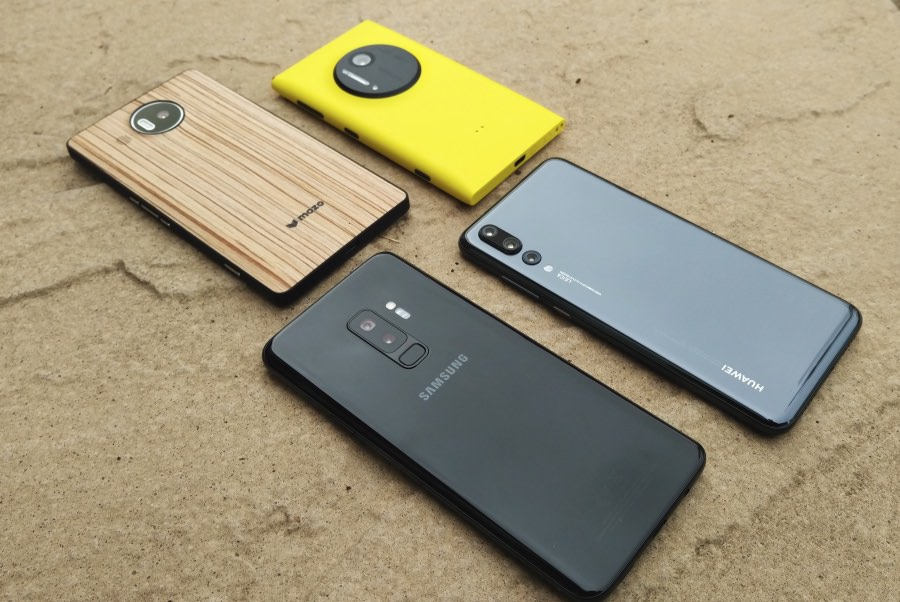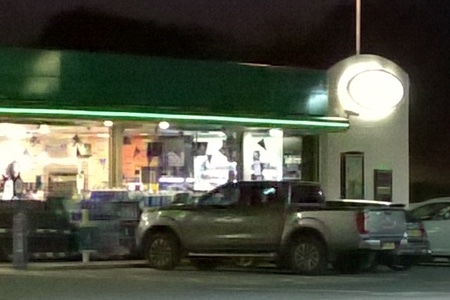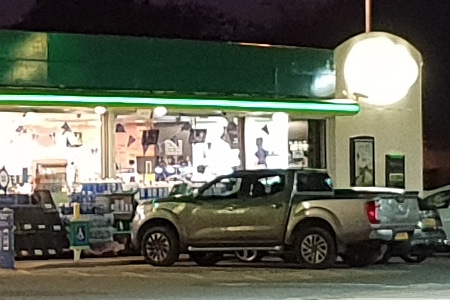
Notable in the photo above is that the P20 Pro, bottom right, is trying to escape from my balanced cluster - it's oleophobic to an extent that you wouldn't believe, and will slide off any flat surface, whether on its front or back. Ditto the S9+, bottom left - both phones have to ALWAYS be in cases in real life use. Just a friendly warning!
To recap, the 40MP 1/1.7" sensor on the Huawei P20 Pro is used in a Quad Bayer configuration, rather than a strict 'PureView' oversampling system. Which is odd, unless the latter is patented by Nokia. The Quad Bayer system does still keep the 'super-pixel' idea (about 2 microns), but it's all a bit rough and ready compared to what Nokia implemented back in 2012/2013, not least because the sensor can't be used for 'PureView' zoom in quite the same way.
On the other hand, the aperture is larger here, plus an extra (OIS-stabilised) 3x telephoto lens takes on the brunt of zooming functions, and a further 20MP monochrome sensor gathers extra detail to throw into the now somewhat heady mix.
How does it all work? A little patchily, as you'll see below - I get the impression that combining all this pixel data isn't trivial and that many further software updates will be needed by Huawei to really get close to the potential of the three sensor system. I'll press on with the review/comparison though, since many people have been asking for it. In fact, I'll throw in the other modern superphone that I've been testing in detail, the Samsung Galaxy S9+ (also with telephoto lens and covered here already).

In the test cases below, I treated the phones as a regular user would on a typical day out, looking at touristy scenes and detail, often with zoom, sometimes in low light, and so on. In each test case I'm looking for slightly different things in the results, but I'll come to all that below.
Because I'm comparing (sometimes zoomed) output from no less than four different smartphone cameras, I've adopted a grid of 1:1 crops (or scaled images where I'm looking for image characteristics rather than raw quality), making it easy to compare the same subject detail from all four at the same time.
As detailed in my guide to PureView zoom, the Lumia 1020 zooms to around 2.5x in its default 5MP mode, the Lumia 950 to about 1.5x in its 8MP mode, while the S9+ zooms to 2x in good light using its telephoto lens, though at 9MP, which shouldn't be too far off what the Nokias unit produces in terms of resolution. In low light, the Nokia pair maintain their lossless zoom, though the quality loss from not having oversampling is then more obvious.
The new Huawei P20 Pro mainly zooms using its optically stabilised 3x telephoto lens, but it also claims '5x hybrid zoom', by which Huawei means that it adds in detail from the other two sensors, along with multi-exposure technology and interpolative techniques. How well does this work? Let's find out.
Test 1: Sunny bluebells
A straightforward and pretty nature shot - nothing tricky here, hopefully - just flowers lit artily amidst a shady grove. Here's the overall scene:

You can grab the original test images from the Lumia 950 XL, Nokia Lumia 1020, Samsung Galaxy S9+ and Huawei P20 Pro here, if you want to download them and do your own analysis.
And here are the promised detailed 1:1 crops from the shots, in sequence from the Lumia 950 XL and Lumia 1020 (the top row), to the Galaxy S9+ and Huawei P20 Pro (the bottom row):




There's not that much between the shots, to be honest, other than the Lumia 1020's result looks most natural (by a small margin) and the P20 Pro's shot looks the most heavily sharpened, and thus the most artificial (again by a small margin, you could argue all this either way). Of note in many of these test shots is that the P20 Pro has an 'AI' function that leaps in to alter camera settings if it detects a certain type of subject (in this case 'flowers') - the main effect of this is usually in white balance and saturation, so I haven't majored on this aspect on this page.
Scoring: Lumia 950 XL: 10 pts, Lumia 1020: 10 pts, Galaxy S9+: 10 pts, P20 Pro: 9 pts.
Test 2: Lilac!
Another easy shot - a flower macro, typical of an end user snap. Here's the overall scene:

You can grab the original test images from the Lumia 950 XL, Nokia Lumia 1020, Samsung Galaxy S9+ and Huawei P20 Pro here, if you want to download them and do your own analysis.
And here are the promised detailed 1:1 crops from the shots, in sequence from the Lumia 950 XL and Lumia 1020 (the top row), to the Galaxy S9+ and Huawei P20 Pro (the bottom row):




Again, there's little to choose between the photos - the two Lumias had the best dynamic range, interestingly, but detail is excellent across the board, as you'd expect.
Scoring: Lumia 950 XL: 10 pts, Lumia 1020: 10 pts, Galaxy S9+: 9 pts, P20 Pro: 9 pts.
Test 3: Fill in flash and HDR
A challenging shot of a statue in shade but with a bright sky and general background. With the idea of testing HDR and also trying a little 'fill in flash', I enabled the flash on all four phones. Here's the overall scene (shot on the Lumia 1020 in this case):

You can grab the original test images from the Lumia 950 XL, Nokia Lumia 1020, Samsung Galaxy S9+ and Huawei P20 Pro here, if you want to download them and do your own analysis.
And here are the shots, not 1:1 crops this time, but scaled to fit here, as I wanted to give a sense of overall capture, in sequence from the Lumia 950 XL and Lumia 1020 (the top row), to the Galaxy S9+ and Huawei P20 Pro (the bottom row):




You may have guessed that by 'fill in flash' I was throwing the Lumia 1020 a 'bone' and you'd be right. But the true Xenon flash on the 1020 is a bigger selling point than most people realise - Xenon isn't just about freezing people at parties (though see below), it's also about filling in light where a subject is backlit, as here. As a result, the Lumia 1020's photo is head and shoulders above the others, though the 950 again was the best of the rest, thanks perhaps to the 'triple LED' flash on board.
Scoring: Lumia 950 XL: 8 pts, Lumia 1020: 10 pts, Galaxy S9+: 7 pts, P20 Pro: 6 pts.
Test 4: Zoom time
Time for some zoom examples. With PureView sensors (the Lumias) and telephoto lenses, let's see what they can do. Note that I'll be sticking to zooming in good light, as you can't zoom in bad light with any of these phones - the Lumias lose their oversampling, the telephoto lenses get ignored because of their smaller apertures.
I zoomed to about 3x on the Lumia 950 (way into digital range, but that's the only way it's competing here!), to the maximum 2.5x on the Lumia 1020, to the physical 2x on the S9+ and to the physical 3x on the Huawei P20 Pro. Note that there's not as much help from zoom into the 40MP sensor on the latter as you might think. As I understand it, the Quad Bayer configuration limits the PureView zoom - this would max out at less than 3x anyway, but the blocks of coloured sub-pixels limit useful colour and detail when zooming.
Here's the overall (unzoomed) scene, a sunny fountain:

You can grab the original zoomed test images from the Lumia 950 XL, Nokia Lumia 1020, Samsung Galaxy S9+ and Huawei P20 Pro here, if you want to download them and do your own analysis.
And here are the promised detailed 1:1 crops from the shots, in sequence from the Lumia 950 XL and Lumia 1020 (the top row), to the Galaxy S9+ and Huawei P20 Pro (the bottom row):




The Lumia 1020 shows its class here, I'm afraid, with a runaway win. Partly better optics, of course, partly the larger sensor, but mainly the wonderful PureView algorithms, creating an image that's pure and real even at 1:1 here. Just look at the moss on the fountain stone, look at the delicate tree branches behind. The 950 devolves to ugly and blocky digital zoom here, so we'll discount it, there just isn't the detail.
The Galaxy S9+ produces a passable result, but the typical Samsung over-sharpening is a bit hard to stomach - again, look at the rendition of the moss and the background foliage. What's most surprising is how bad the Huawei P20 Pro is here - zooming is supposed to be its 'thing', yet all fine detail is horribly blocked out by the brutal algorithms used. When I saw this at the pixel level I wanted to call up Eero Salmelin and check what the heck was going on in his labs. I couldn't believe that this result was from the same guy who helped create the ultra-pure Nokia 808....
Scoring: Lumia 950 XL: 6 pts, Lumia 1020: 10 pts, Galaxy S9+: 9 pts, P20 Pro: 5 pts.
Test 5: Maximum zoom
After the P20 Pro disaster above, I figured that maybe the algorithms were tuned better for straight lines and 'things' rather than nature. I was also aware that Huawei was trumpeting a '5x hybrid zoom', using data from all three sensors. So I decided to try all this out. I went to roughly 5x on the Lumia 950(!), on the S9+ and the P20 Pro, digital zoom be damned (the 1020 is limited to lossless, non-digital zoom, so maxes out at 2.5x). Here's the overall (unzoomed) scene:

You can grab the original test zoomed images from the Lumia 950 XL, Nokia Lumia 1020, Samsung Galaxy S9+ and Huawei P20 Pro here, if you want to download them and do your own analysis.
And here are the promised detailed 1:1 crops from the shots, in sequence from the Lumia 950 XL and Lumia 1020 (the top row), to the Galaxy S9+ and Huawei P20 Pro (the bottom row):




Expecting a phone camera to pull off 5x zoom is a little unrealistic, especially shooting into light, as I was here. So I was pleasantly surprised by all the results here. Even the Lumia 950's digital zoom result isn't too monstrous. At 5x, the S9+'s hybrid zoom is way out of its comfort range here and is full of artefacts, while my hunch was right and the P20 Pro's zoom image processing is much happier with straight lines and edges - the P20 Pro's image is almost artefact free and superior.
Scoring: Lumia 950 XL: 5 pts, Lumia 1020: 5 pts, Galaxy S9+: 7 pts, P20 Pro: 9 pts.
Test 6: One last zoom
After the fountain disaster, I was determined to get another data point from 2-3x zooming. So I found another pretty location. Here's the overall (unzoomed) scene:

You can grab the original test images from the Lumia 950 XL, Nokia Lumia 1020, Samsung Galaxy S9+ and Huawei P20 Pro here, if you want to download them and do your own analysis.
And here are the promised detailed 1:1 crops from the shots, in sequence from the Lumia 950 XL and Lumia 1020 (the top row), to the Galaxy S9+ and Huawei P20 Pro (the bottom row):




The Lumia 950 image is typically blocky - 2.5x (or so, it's hard to tell in the UI!) is beyond its PureView zoom limit, while the Lumia 1020 stuns by sticking to its 2.5x zoom limit and restrained sharpening - just look at the natural detail in the grass. The S9+'s 2x telephoto does a decent job too, but I'd still like Samsung to provide a way to dial back its sharpening. And lastly - oh dear - the P20 Pro completely belies its PureView heritage by producing a blocky, ugly result that's no better than the Lumia 950's. I'm appalled, quite frankly, at how Huawei let the P20 Pro be sold with its image processing in this state - zooming to 3x is supposed to be trivial for the handset, and it's clearly not.
Scoring: Lumia 950 XL: 6 pts, Lumia 1020: 10 pts, Galaxy S9+: 9 pts, P20 Pro: 6 pts.
Test 7: Low light
But back to non-zoomed shots, here showing a garage at night. Here's the overall scene:

You can grab the original test images from the Lumia 950 XL, Nokia Lumia 1020, Samsung Galaxy S9+ and Huawei P20 Pro here, if you want to download them and do your own analysis.
And here are the promised detailed 1:1 crops from the shots, in sequence from the Lumia 950 XL and Lumia 1020 (the top row), to the Galaxy S9+ and Huawei P20 Pro (the bottom row):




The P20 Pro at last manages to 'win' a test here, with excellent dynamic range, thanks to multi-exposure technology and despite not having OIS on its main 40MP lens (frame alignment software steps in). Yes, the details show some artefacts, but not unreasonably so. The S9+'s shot is clearer, the 1020's even more so (look at the alloy wheels on the truck), while the Lumia 950 XL comes in last in a low light test - now when was the last time that happened here on AAWP?
Scoring: Lumia 950 XL: 7 pts, Lumia 1020: 8 pts, Galaxy S9+: 9 pts, P20 Pro: 9 pts.
Test 8: Party time
My famous party mock-up test. Me with a bottle (I've moved on to vodka!) and not trying to stay particularly still, with a willing amateur volunteer taking the shot handheld. Here are scaled crops from the original shots, in sequence from the Lumia 950 XL and Lumia 1020 (the top row), to the Galaxy S9+ and Huawei P20 Pro (the bottom row):




You might remember a few years ago when such tests were a blurry mess for most competing phones? Things have certainly improved, though despite the larger apertures and improved capabilities of the competition, it's the Lumias which keep on producing the best results. Here with the 1020 and its Xenon flash winning out (of course), but with the Lumia 950 XL and its triple LED plus 'Dynamic Flash' system also producing a good result. The S9+ and P20 Pro both keep shutter speed fast-ish, 1/50s and 1/30s respectively, meaning that there's not too much motion blur, but at the expense of their photos needing enhancement by the user to brighten them up before social sharing.
Scoring: Lumia 950 XL: 8 pts, Lumia 1020: 10 pts, Galaxy S9+: 7 pts, P20 Pro: 7 pts.
Conclusions
Adding up all the points scores gives us:
- Lumia 1020: 73/80 pts
- Galaxy S9+: 67/80 pts
- Lumia 950 XL: 60/80 pts
Huawei P20 Pro: 60/80 pts
It turns out that the rose-tinted view we all have of the classic Lumia 1020 is still fully justified - putting it up against the best of today when there's zooming and flash to be tested still results in an outright and convincing win. Which is odd in the context of the new Huawei P20 Pro, which claims to be the 'best' - it even had DxOMark credit it as such and by a huge margin.
But I disagree. Based on my testing above ('SteveMark'?), the P20 Pro isn't anywhere near 'best' yet, and it's clear that significant software upgrades are needed before it'll trump the current all-round champion, the Samsung Galaxy S9+, let alone challenge for 'best ever'. Will Huawei, led by Eero Salmelin, have the commitment to sort out the current triple sensor image processing mess? Huawei's track record with updates has always been a bit patchy. We'll see...
In the meantime, yes, your eyes don't deceive you, a 2013 camera phone just walked away with a resounding win against 2018 competition. Really.
Comments welcome - I'm sure you'll want to have your say on my verdicts!
